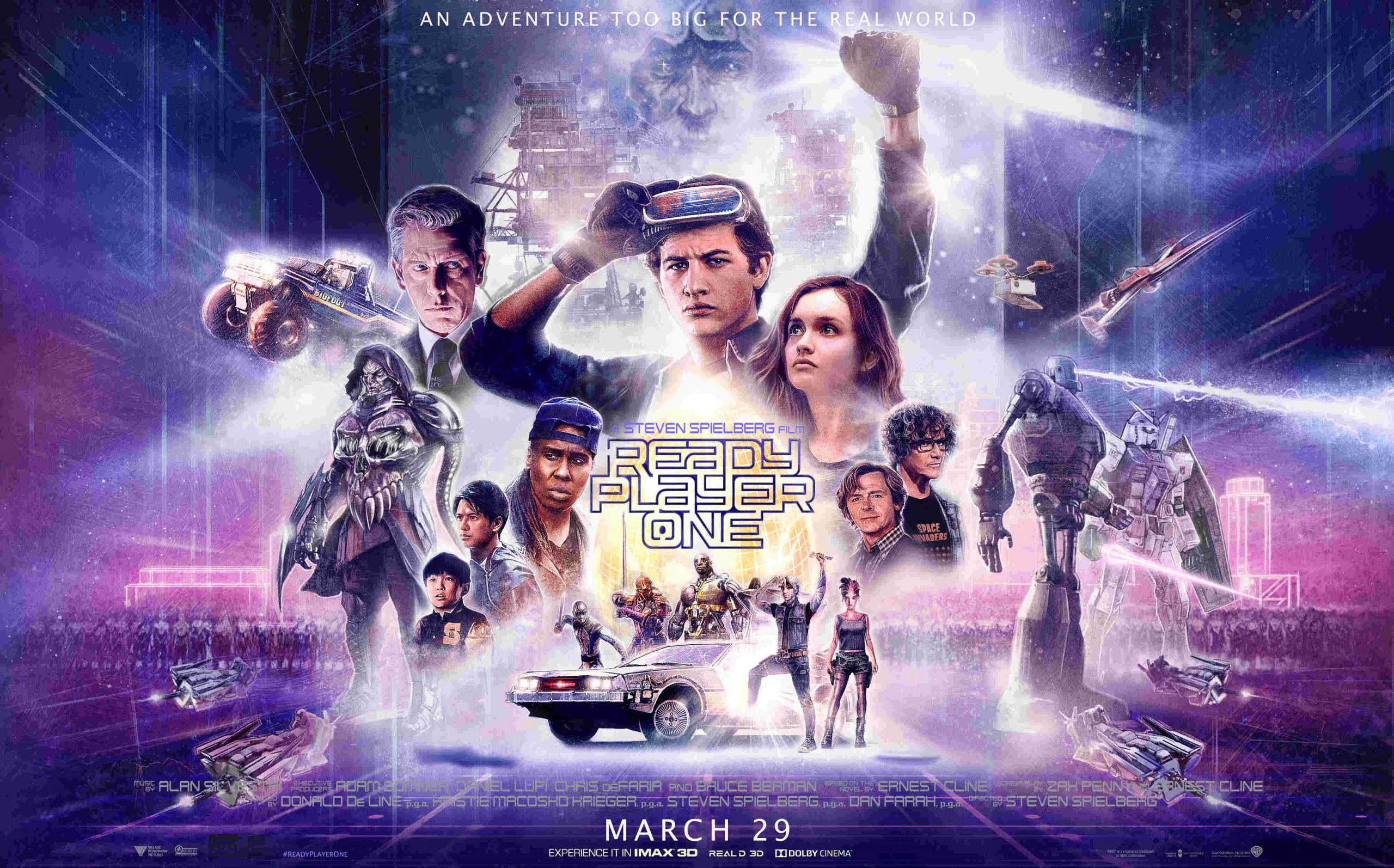
Ready Player One (RP1) is a flawed novel. Among its blemishes is its narrow focus in that it was written for readers to get “it” — the “it” being the cultural artifacts of the 80s. It appealed to those who remember Pac Man, Popeye and Donkey Kong arcade cabinets, Galaga-type shooters, Ghostbusters, Ferris Bueller and A-Ha!, and those who thought that Molly Ringwald was going to be the best actress in the world forever. The Delorean DMC-12 was the coolest car in the world, followed by Kit from Knight Rider; Dungeons and Dragons was so seriously real that religious leaders and concerned relatives felt a need to confiscate your d20s and 12s as well as your Player’s Handbook and Dungeon Master’s Guide.
If you got those references, you should have felt a quick shot of dopamine course through your body — such is the power of nostalgia. The book, though boasting a quest at its heart, wizards, puzzles and a bad guy, is a matrix of arguably empty nostalgia that nevertheless sends a jolt of pleasure every now and then to the reader in the know. The characters of the book, similarly, had little about them except for their own obsession with the 80s. Perhaps the only detail well-fleshed out in the book, albeit briefly and in flashes, is the sorry state of the planet.
A quick rehash of the overall story:

21st-century earth is a shithole. The only escape is The Oasis, a virtual wonderland created by eccentric genius James Halliday. The Oasis, a reprieve from reality, enjoys mass success and becomes a surrogate for reality. Schools and lessons are held in the virtual world, and it’s also the platform for most business and commercial transactions. Corporations make a mint selling hardware and advertising space to Oasis users, and could probably be making a lot more if not for the restrictions imposed by Halliday.
Commercial restrictions aside, Halliday has also designed The Oasis as a homage to the 1980s due to his lifelong obsession with the decade. Following his death, Halliday announces a quest, the winner of which will be the beneficiary of half a trillion dollars and become the sole owner of Oasis. This sparks a massive hunt by individuals and corporations alike for the quest’s prize — an Easter Egg hidden somewhere within the VR world. These Egg Hunters, or Gunters, need to overcome three puzzles to retrieve the Egg.
Wade Watts is one such Gunter. He solves the first quest — the first to do so in the years since the quest was first announced — and becomes the hottest asset in The Oasis. This puts him in the cross-hairs of other Gunters as well as IOI Corporation, a nefarious company seeking to gain ownership of The Oasis for commercial exploitation. To ensure the Oasis is safe from IOI, Wade, together with his loose coalition of friends, must solve the puzzles and find the Egg before IOI does.
What the Movie Does Well
As with most movie adaptations, the movie is a fraction of the length of the book but manages to address a critical flaw in the book, namely, the flatness of the characters. Character definition was poorly executed in the book leaving readers with a fairly forgettable description of the main characters save that they were all obsessed with the 80s, two of them were good and one of them was evil. The movie, by giving the protagonist’s love interest Art3mis a greater sense of purpose, gives her greater depth as a person and not just an online persona as represented in the book. Wade, unfortunately, remains as uninteresting as he was in the book.
The movie also rejigs the quests the Gunters have to solve from the book. No doubt the quests in the movie — a Mario Kart-ish race, and a set-piece based on Stanley Kubrick’s The Shining — were chosen because it made for better visuals than the book’s. The latter involved mainly arcade cabinets and old text adventure games. The cinematography and planning for The Shining stand out in particular, even if zombies were added to it. In hindsight, the quest revisions in the movie helped sweep away a lot of unnecessary geek humour littering the book. For example, the first quest in the book involved playing Joust with an undead lich.
The final battle was certainly fun even if it did revert to the RP1‘s formula of invoking nostalgic artefacts, but this time from the not so distant past. Keep an eye out for the following characters in the Battle of Anorak:
- Master Chief, Halo
- Tracer, Overwatch
- Robocop (in the original silver)
- Lara Croft, Tomb Raider
There’s a lot more. There’s even a shout-out to Cameron Crowe’s Say Anything in the final battle. But see what I did there? Just as the movie does, I’m establishing my pop culture cred by being able to pick out all these references and cultural artefacts and thereby raising my esteem amongst my peer groups (one hopes). It’s pretty much what Rob Gordon in Nick Hornby’s High Fidelity says: “What really matters is what you like, not what you are like.”
What the Movie Doesn’t Do So Well
Casting. Tye Sutherland (who looks like a cross between Tom Hardy and Ashton Kutcher) was not a good choice for Wade Watts and was comprehensively outdone by his Oasis avatar in almost every way. I was unpersuaded by his motivations in the movie and his character is too shell-shocked and overwhelmed to lead an army in the final battle. It’s also inconceivable that Art3mis played by Olivia Cooke would develop any romantic feelings for him. Wade is at worst a selfish brat and at best a juvenile naif.
The Big Picture. In the William Gibson Neuromancer universe, the price humanity pays for virtual-fication of reality is clearly spelled out. The trade off is much less clear in RP1 where The Oasis exists as a gaming wonderland. Yet clearly a price has to be paid because one of the “improvements” introduced by Wade and Art3mis in the movie is regular shutdowns for the virtual world so people would switch-off to engage in the real world. This didactic point is raised throughout the movie as well, although it never really offers a good reason why the real world is better. It’s fundamentally a philosophical question but perhaps a good thing that the hoary chestnut was left undeveloped.
Empty nostalgia. This is more of a pet peeve than legitimate criticism of the movie but I’ve always wondered if nostalgia is a legitimate literary device. Must we distinguish between empty nostalgia and ostensibly the kind that’s more full and meaningful? And is it fair to expect the latter from a movie as, after all, nostalgia is a subjective function? So while on the one hand, I enjoyed (on some primitive level) recognising certain references, there is also another part of me that feels a bit tawdry because of the cheap thrill.
Verdict
My first impression after watching the movie was that the book was better. But now that I’ve revisited the book again, I am reminded of the flaws that made this book really slow going. After all that’s said and done, it’s a Spielberg movie and those seldom venture into the unwatchable terrain. It’s also got some great CGI and effects. The book, meanwhile, retains some charm although it will appeal more to those who grew up in the 80s.
So 80s nerds and geeks: Read the book and watch the movie. Everyone else should probably just stick with the movie.
